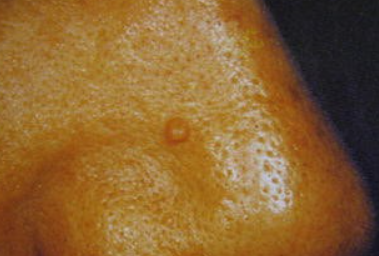Fibrous papule of the nose is an acquired benign clinical and histopathological variant of angiofibroma, characterized by the appearance of a single (sometimes multiple) papule on the nose and occasionally on other parts of the face. ICD-10 code: D23.39
This condition is commonly found in middle-aged individuals (30-40 years old), without ethnic differences, and is more common in men. The prevalence is relatively high, but there is no reliable information on the frequency of the disease.
The exact etiopathogenesis is unknown. In the past, it was considered to be a dermal nevus that had undergone fibrosis and did not synthesize S100 protein. Currently, most authors consider fibrous papules to be a sporadic clinical and histologic variant of angiofibroma and a synonym for perifollicular fibroma. The primary theory of pathogenesis involves reactive proliferation of dermal dendritic cells in response to external irritating factors (trauma).It is characterized by the appearance of a solitary, hemispherical papule with a smooth surface, ranging in color from flesh-colored, white to red, and having a firm consistency up to 6 mm in diameter. The base of the papule is typically broad, but polypoid forms are also seen. The predominant sites are the nose, nasal wings, nasolabial fold, and less commonly the forehead, cheeks, chin, and neck. In some cases, multiple elements may occur.
There are usually no subjective symptoms and bleeding after trauma is rarely observed. The course is persistent without progression, and cases of spontaneous resolution have not been reported.- Basal cell carcinoma
- Dermal nevus
- Angiofibromas associated with genodermatoses:
- Tuberous sclerosis
- Birt-Hogg-Dubé syndrome
- Multiple endocrine neoplasia type 1
- Neurofibromatosis type 2
- Pyogenic granuloma
- Flat wart
- Sebaceous hyperplasia

